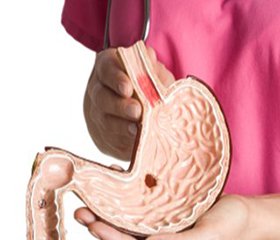Журнал «Здоровье ребенка» 2 (61) 2015
Вернуться к номеру
Endoscopic evidence of ulcer disease in children complicated gastrointestinal bleeding.
Авторы: Sokolnyk S.O. — Bukovinian State Medical University, Chernivtsi
Рубрики: Педиатрия/Неонатология
Разделы: Клинические исследования
Версия для печати
Introduction. The problem of peptic ulcer remains valid in connection with the annual increase in the number of patients with complicated disease, the most common among them as among adults and among children is gastrointestinal bleeding.
Aim of the study. Evaluate the range of endoscopic parameters in children with uncomplicated peptic ulcer disease and complications of gastrointestinal bleeding.
Material and methods. The analysis of the clinical and endoscopic examination of 76 children with peptic ulcer. Verification of clinical diagnosis was carried out in accordance to the treatment of children in «Children's Gastroenterology» (Ministry of Health of Ukraine №59 of 01.29.2013 y.). Diagnostic of H. pylori was carried cytoscopy, ELISA and molecular-genetic research methods. Inflammatory and degenerative changes in the lining of the stomach and duodenum were assessed using criteria Grigoriev P.Y. The severity of bleeding and its stability was assessed by classification S.A. Forrest et al. (1974): active bleeding (FIA, FIB); bleeding that occurred (FIIA, FIIB, FIIC, FIII). Survey results statistically processed using the software package «STATISTISA V.6.0».
Results. We conducted a comprehensive examination of children with ulcer showed heterogeneity of clinical disease, accompanied by a variety of morphofunctional structure. In 22 (34,4%) of 64 children diagnosed with uncomplicated peptic ulcer disease (group I), which are directed to the gastroenterology departments, endoscopy showed signs of bleeding. These were children with no obvious signs of active bleeding, but they diagnosed degree FIIB, FIIC. The vast majority of these children asked for medical help for 2-3 days from the onset of clinical signs of disease. Therefore, the study of endoscopic picture we carried these children in the group with complication of disease (group II).
H. pylori was detected in 89,5% of patients. In children II group the figure was significantly higher than that of I group patients (97,1% and 83,3%, t = 2,13, p <0,05). The positive correlation in the II group of children between the observed titer antibodies to H. pylori antigen and activity bleeding (r = 0,43, p <0,05).
In children with gastrointestinal bleeding significantly more often diagnosed with a high degree of sowing mucosa than in the I group (t = 5,57, p <0,05), while the last one probably diagnosed with greater frequency average degree (t = 2,85, p <0,05).
The positive correlation in the second group of children between the activity and the presence of bleeding H. pylori infection (r = 0,52, p <0,05), and between activity level and sowing bleeding mucosa H. pylori (r = 0,46, p <0,05).
Children in both groups established predominance of lesions of the mucous membrane of the duodenum on gastric mucosal lesions (pφ <0.01) with the most frequent localization of ulcers in the duodenal bulb (59 (95.2%), p <0.01). Comparative analysis of localization of lesions in the duodenal bulb of both groups established probable prevalence of lesions in the posterior wall of patients with gastrointestinal bleeding than patients with uncomplicated outcome peptic ulcer (51,9% and 25,0%, t = 2,16, p <0.05).
In 64 (84,2%) cases diagnosed solitary ulcer; multiple ulcerative defects found only in 12 (15,8%) patients. Although multiple ulcers occurred more frequently in patients with uncomplicated ulcer (t = 1,62, p> 0.05).
Children in both groups dominated ulcers small and medium sizes. Large ulcers diagnosed in only 4 (11,8%) patients of the II group.
Children of I group III diagnosed less likely level of activity of inflammation, compared with children with gastrointestinal bleeding ulcer genesis (4,8% and 23,5%, t = 2,35, p <0,05), but significantly more in they recorded І degree (61,9% and 32,4%, t = 2,69, p <0,05). II degree of activity of inflammation was found in 33,3% of children with uncomplicated peptic ulcer, and 44,1% of patients with gastrointestinal bleeding (t = 0,96, p> 0,05).
Duodenogastric reflux often diagnosed in children with gastrointestinal bleeding (41,2% and 19,1% respectively, t = 2,13, p <0,05).
In children with uncomplicated ulcer was diagnosed significantly more increased kyslotoprodukuvalnu function of the stomach in a state subcompensation unlike patients with gastrointestinal bleeding (t = 2,06, p <0,05).
Conclusion. Thus, the study of endoscopic picture of peptic ulcer disease in children has allowed us to determine the features depending on the presence of bleeding.

